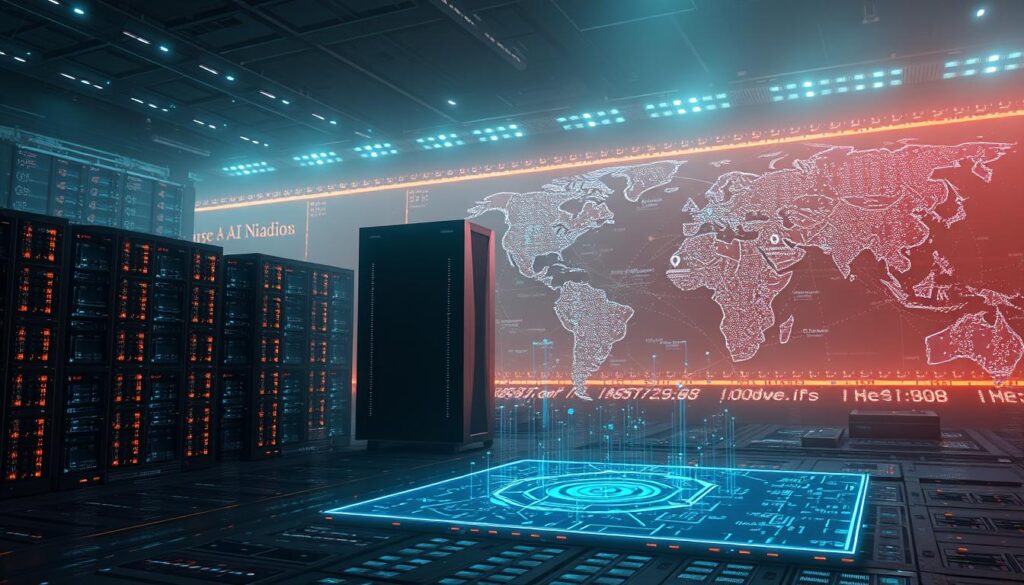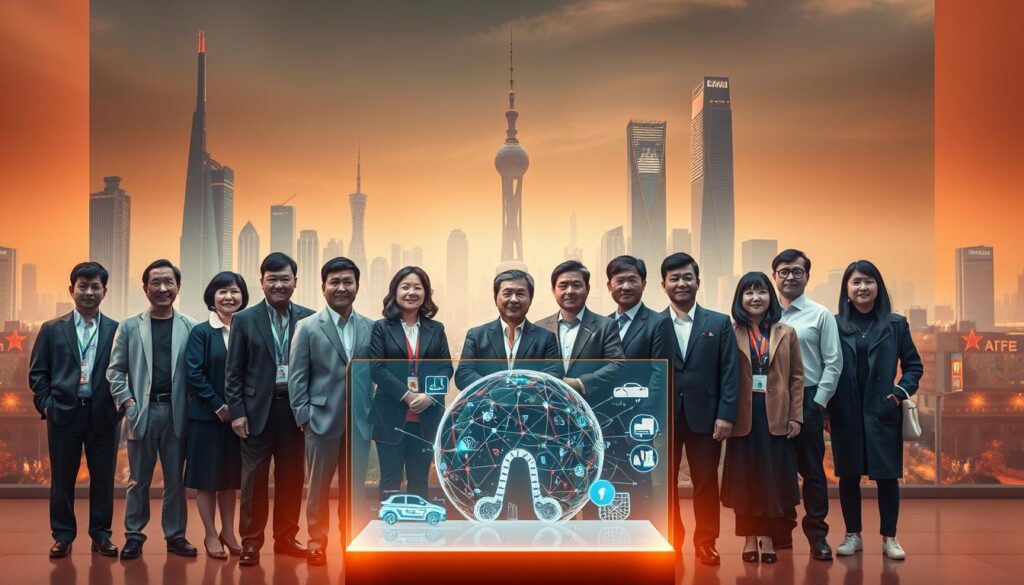“The future belongs to those who believe in the beauty of their dreams,” said Eleanor Roosevelt. This sentiment rings true in the world of artificial intelligence, where innovation is reshaping the technological landscape. The race for supremacy in this field is intense, with nations vying to lead the charge.
Artificial intelligence is not just a tool; it’s a transformative force. It drives economic growth, national power, and societal change. The U.S. attracted $67.2 billion in private AI investment in 2023, while China secured $7.8 billion, highlighting the growing competition1. This rivalry is shaping the future of innovation.
Historical advancements and cutting-edge developments are setting the stage. The U.S. developed 61 notable machine learning models in 2023, compared to China’s 151. Yet, Chinese models like Alibaba’s Qwen are gaining traction globally, showcasing their strategic edge2.
This article explores the technological, economic, and geopolitical dimensions of this race. It integrates perspectives from both the U.S. and China to answer the central question: Who will lead the AI revolution?
Key Takeaways
- Artificial intelligence is a key driver of economic and national power.
- Innovation is reshaping the global technological landscape.
- The U.S. leads in private AI investment and machine learning models.
- Chinese AI models are gaining global recognition and usage.
- The competition between nations is intensifying, shaping the future of AI.
Overview of the Global AI Landscape

The rapid evolution of technology is driving global advancements in artificial intelligence. From healthcare to transportation, AI is transforming industries and reshaping economies. This progress is fueled by cutting-edge research and significant investments in infrastructure.
Key components of AI systems include advanced computing power and data centers. These elements are essential for processing vast amounts of information quickly and efficiently. Governments and private companies are collaborating to build robust infrastructure that supports AI development3.
Market forces and technological breakthroughs are deeply interconnected. Innovations in machine learning and natural language processing are pushing the boundaries of what AI can achieve. For example, private investment in generative AI surged from $650 million in 2023 to $3.15 billion in 20243.
Comparative research highlights the roles of different nations in this race. While some countries focus on regulatory frameworks, others prioritize rapid deployment and scalability. This diversity in approaches is shaping the future of AI on a global scale.
| Key Component | Description |
|---|---|
| Advanced Computing | High-performance systems for processing complex algorithms. |
| Data Centers | Facilities that store and manage vast amounts of data. |
| Research Output | Innovations and discoveries driving AI advancements. |
As AI continues to evolve, its impact on society and the economy will only grow. Understanding the current landscape is crucial for analyzing future trends and capabilities. For more insights on how AI is revolutionizing industries, explore AI-powered transportation solutions.
Historical Context of US-China Tech Rivalry

The roots of the U.S.-China tech rivalry trace back to the Cold War era. During this period, the U.S. established itself as a leader in innovation, driven by significant investments in research and infrastructure. This early dominance set the stage for its later global leadership in technology4.
China’s emergence as a tech powerhouse began in the 1980s with economic reforms. Programs like the 863 Programme aimed to boost technological development and reduce reliance on foreign expertise. These initiatives laid the groundwork for China’s current capabilities in the tech industry5.
The 1990s saw both nations adopt differing approaches. The U.S. focused on private sector innovation, while China emphasized state-led policy and strategic investments. This divergence shaped their respective trajectories in the tech race6.
Cold War Origins and Early US Dominance
During the Cold War, the U.S. invested heavily in technology to counter Soviet advancements. This era saw breakthroughs in computing and telecommunications, which solidified its position as a global leader. Companies like IBM and Intel became symbols of American innovation4.
By the 1980s, the U.S. controlled a significant share of the global electronics industry. Its dominance was further reinforced by policies that encouraged private sector growth and collaboration with academia5.
China’s Economic Reforms and Initial Tech Emergence
China’s tech journey began with the 863 Programme in 1986. This initiative focused on advancing key technologies, including biotechnology and information systems. It marked the start of China’s shift from an agrarian economy to a tech-driven one6.
In the 2000s, policies like Made in China 2025 aimed to transform the nation into a high-tech manufacturing hub. These efforts have positioned China as a formidable competitor in the global tech landscape5.
Understanding this historical context is crucial for analyzing the current tech rivalry. It highlights how past initiatives continue to influence the capabilities and strategies of both nations today.
Current AI Capabilities: US vs China

The race for technological supremacy is reshaping industries worldwide. Both the U.S. and China are making significant strides in artificial intelligence, but their approaches and outcomes differ. Understanding these differences is key to analyzing their future trajectories.
Research Output and Technological Infrastructure
The U.S. leads in elite AI researchers, with 57% of top-tier talent based in its institutions7. This strong foundation supports cutting-edge advancements in machine learning and natural language processing. In contrast, China has outpaced the U.S. in AI patent filings, with over 38,000 patents granted in 20238.
China’s focus on innovation is evident in its research output. It accounted for 61.1% of global AI patent origins in 20227. This commitment to intellectual property reflects its strategic goal of becoming a leader in the field.
Deployment Speed and System Scalability
China excels in rapid deployment of AI systems. Models like DeepSeek-V3, trained on a budget of less than $6 million, showcase its cost efficiency and scalability8. This approach allows for widespread adoption across industries, from healthcare to finance.
The U.S., on the other hand, emphasizes high-performance computing. Models like Llama 3 use significantly more compute resources, reflecting a focus on precision and complexity8. This strategy ensures robust system design but may slow deployment speed.
Both nations are leveraging their strengths to shape the future of AI. While the U.S. prioritizes research and innovation, China focuses on practical applications and scalability. These divergent strategies highlight the dynamic nature of the AI landscape.
Future Trends in AI Innovation

Innovation in artificial intelligence is accelerating at an unprecedented pace, opening doors to transformative possibilities. Emerging domains are reshaping industries, creating new opportunities for growth and disruption. From healthcare to finance, AI is poised to redefine traditional business models and set new industry standards.
The market for AI applications is projected to expand significantly in the coming years. Generative AI, in particular, is expected to drive major changes, with over 25% of patents in this sector emerging in the last year alone9. This rapid growth highlights the increasing importance of staying ahead in the competitive race for AI dominance.
One of the most promising areas is the integration of AI into healthcare. Predictive analytics and personalized treatment plans are just the beginning. Breakthroughs in natural language processing are also enabling more intuitive interactions between humans and machines, paving the way for smarter virtual assistants and customer service solutions.
Private companies and public institutions alike are exploring innovative applications of AI. For example, advancements in diffusion models are revolutionizing creative industries, from graphic design to content creation9. These technologies are not only enhancing productivity but also opening up new revenue streams.
Market forces are aligning with technological innovation, creating a fertile ground for further advancements. Research in quantum computing and semiconductor manufacturing is expected to play a crucial role in shaping the future of AI10. These developments will likely lead to transformative breakthroughs that redefine what is possible.
To stay competitive, organizations must invest in research and development. For insights into how AI is driving economic growth, explore AI-powered investment opportunities. The future of AI is bright, and those who embrace innovation will lead the way.
Key Battlegrounds in AI Development
![]()
The competition for leadership in artificial intelligence is intensifying, with key areas emerging as critical battlegrounds. These include semiconductor manufacturing, quantum computing, data resources, and talent acquisition. Each of these elements plays a pivotal role in shaping the future of innovation.
Semiconductor Manufacturing and Quantum Computing
Advanced chips are the backbone of artificial intelligence systems. They power everything from data centers to autonomous vehicles. The U.S. has imposed export controls to limit access to critical semiconductor technologies, highlighting their strategic importance11.
Quantum computing is another frontier. It promises to revolutionize AI by solving complex problems faster than traditional systems. Investments in this field are growing, with both nations vying for dominance12.
Data Resources and Talent Acquisition
Vast datum resources are essential for training and refining AI models. Access to high-quality data sets can significantly enhance system performance. However, challenges like data privacy and regulatory compliance remain13.
Talent acquisition is equally critical. Skilled researchers and engineers drive innovation. The U.S. attracts top-tier talent globally, while China invests heavily in education to cultivate its workforce12.
| Key Battleground | Impact on AI Development |
|---|---|
| Semiconductor Manufacturing | Provides the hardware needed for AI systems. |
| Quantum Computing | Enables faster and more complex computations. |
| Data Resources | Supports the training and refinement of AI models. |
| Talent Acquisition | Drives innovation and technological advancements. |
These battlegrounds collectively influence competitive advantage in AI development. Understanding their dynamics is crucial for analyzing future trends and capabilities.
Strategic Advantages and Vulnerabilities

Strategic advantages in technology often determine the trajectory of national success. The U.S. and China each bring unique strengths to the table, shaping their positions in the global tech race. Understanding these advantages—and their vulnerabilities—is crucial for analyzing future outcomes.
US Strengths in Research and Private Sector Innovation
The U.S. excels in fostering a robust ecosystem for research and development. Private sector innovation drives advancements, with companies like Nvidia leading in high-performance computing. Nvidia’s A100 and H100 GPUs are critical for training large-scale models, setting a gold standard in the industry14.
This focus on innovation is supported by significant investments. Venture capital flows into startups, enabling breakthroughs in machine learning and natural language processing. However, reliance on private sector growth also introduces risks, such as vulnerabilities to market fluctuations15.
China’s Governmental Support and Rapid Deployment
China’s approach is marked by strong governmental support and centralized planning. Policies like the Next Generation AI Development Plan aim to achieve technological self-sufficiency by 203015. This strategy enables rapid deployment of AI systems across industries.
For example, Huawei’s Ascend 910C processor offers 60% of the inference performance of Nvidia’s H100 GPU, showcasing China’s progress in domestic technology14. However, this reliance on state-led initiatives poses risks, including potential inefficiencies and challenges in adapting to global market demands.
- Control over technological development drives competitive positioning.
- Strategy and risk management are central to national success in the tech sector.
- Both nations face vulnerabilities, such as policy shifts and technological decoupling15.
Balancing strategic planning with unforeseen challenges is key. The U.S. leverages private sector agility, while China relies on state-driven efficiency. Both approaches highlight the importance of control and strategy in shaping the future of technology.
The Role of Government Policies in Shaping AI

Government policies play a pivotal role in shaping the trajectory of artificial intelligence innovation. Strategic initiatives and regulatory frameworks directly influence the pace and direction of advancements in this field. From funding research to setting standards, these efforts are critical in maintaining competitive advantages.
National Investment and Funding Initiatives
Significant investment in AI research and infrastructure is a cornerstone of national strategies. For instance, China’s National AI Team, comprising 23 leading enterprises, provides open access to data and computing power for startups and SMEs16. This approach fosters innovation and accelerates development.
In the U.S., the National AI Initiative Act of 2020 focuses on five key objectives, including increasing research funding and building a robust workforce17. These efforts aim to enhance capabilities and maintain leadership in the global AI race.
Impact of Regulatory Frameworks on Innovation
Regulatory frameworks also play a crucial role in shaping AI innovation. China’s 2022 revision of the Anti-Monopoly Law targets anti-competitive behavior in technology, ensuring fair market practices16. Similarly, the EU’s General Data Protection Regulation (GDPR) sets global standards for data privacy, influencing AI development worldwide16.
However, stringent regulations can sometimes hinder progress. Export controls on advanced semiconductors, for example, have complicated access to critical technologies, impacting AI advancements in certain regions17.
- Government policies directly influence the pace of AI innovation.
- National investment efforts are essential for research and development.
- Regulatory frameworks balance innovation with national security concerns.
Understanding the interplay between policy, funding, and regulation is crucial for analyzing the future of AI. For more insights on how these factors are shaping the industry, explore AI advancements in gaming.
Impact of Export Controls and Compute Power Restrictions

Export controls and compute power restrictions are reshaping the dynamics of international technology collaboration. These measures aim to limit the transfer of advanced technologies, ensuring national security and maintaining competitive advantages. However, they also pose challenges for global innovation and partnerships.
Global Licensing Policies and Country Classifications
Licensing policies play a critical role in determining how compute power is distributed globally. For instance, the Bureau of Industry and Security (BIS) introduced the Framework for Artificial Intelligence Diffusion in January 2025, limiting access to advanced technologies like high-end chips and cloud computing18. These policies classify countries based on their technological capabilities and strategic importance.
Such classifications impact emerging markets significantly. Countries with limited access to advanced computing resources face hurdles in developing competitive AI systems. This creates a divide between nations with robust infrastructure and those without.
Implications for International Collaboration
Export controls and compute power restrictions have far-reaching effects on international collaboration. For example, the number of China-U.S. co-authored AI research articles reached 47,715, highlighting the importance of cross-border partnerships18. However, policies like the Stop CCP VISAs Act threaten to disrupt this collaborative environment by excluding Chinese students from U.S. academic projects18.
These restrictions also impact private sector collaborations. Companies like Apple and Alibaba, or Ford and DeepSeek, face challenges in integrating technologies across borders18. Such barriers hinder the flow of innovation and slow down progress in critical sectors.
- Restriction policies aim to protect national interests but may stifle global innovation.
- Computing resources are increasingly controlled, affecting access for emerging markets.
- Access to advanced technologies is becoming a key determinant of competitive advantage.
In the long term, these measures could lead to a fragmented global tech landscape. Nations may prioritize self-sufficiency over collaboration, potentially slowing down the pace of innovation. Understanding these dynamics is crucial for navigating the future of technology.
US Strategy: Defensive Measures and Innovation Investment

The United States is doubling down on its efforts to secure a leadership position in artificial intelligence. A combination of defensive measures and strategic investments is shaping its approach. These efforts aim to counterbalance restrictive policies while fostering innovation through public-private partnerships.
Public-Private Synergies and Venture Capital Dynamics
Public-private collaboration is a cornerstone of the U.S. strategy. Venture capital plays a critical role, with significant investments driving breakthroughs in machine learning and natural language processing. For example, Nvidia’s A100 and H100 GPUs are pivotal in training large-scale models, setting industry standards19.
Federal initiatives like the CHIPS and Science Act are fully funding research to maintain competitiveness. This approach ensures that innovation remains a priority, even as export controls limit access to advanced technologies19.
Federal Funding and STEM Education Initiatives
Federal funding programs are essential for long-term growth. The National AI Initiative Act of 2020 focuses on increasing research funding and building a skilled workforce. These efforts are complemented by STEM education initiatives that aim to cultivate the next generation of AI talent19.
However, the U.S. ranks low in the percentage of graduates pursuing STEM fields. To address this, programs are being expanded to attract more students, including those from India, who are compensating for the decline in Chinese student enrollment19.
| Initiative | Impact |
|---|---|
| CHIPS and Science Act | Funds research to maintain technological leadership. |
| National AI Initiative Act | Supports workforce development and innovation. |
| STEM Education Programs | Cultivates future AI talent. |
These measures highlight the importance of collaboration in sustaining a competitive advantage. By leveraging public-private synergies and investing in education, the U.S. is positioning itself for long-term success in the AI race.
China’s Alternative AI Approach and Open-Source Diffusion

In the evolving world of technology, nations are crafting unique strategies to lead in artificial intelligence. One standout approach is China’s focus on building an integrated ecosystem through open-source models. This method fosters collaboration and accelerates innovation, setting it apart from more restrictive strategies.
Building an Integrated AI Ecosystem
China’s strategy revolves around creating a cohesive environment for AI development. Open-source models like Zhipu AI and Moonshot AI are central to this effort. These platforms enable rapid prototyping and deployment, reducing barriers for startups and SMEs20.
State support plays a crucial role in this ecosystem. Policies like the Next Generation AI Development Plan provide funding and resources, ensuring sustained growth20. This approach contrasts with the U.S.’s reliance on private sector innovation, highlighting China’s unique path.
Global Market Strategies and Digital Silk Road
China’s influence extends beyond its borders through initiatives like the Digital Silk Road. This project aims to expand its technological footprint globally, offering infrastructure and expertise to partner countries21.
By leveraging its domestic capabilities, China is closing the technology gap. For example, its DeepSeek-R1 model is more efficient and open-source compared to Western alternatives20. This strategy not only enhances its global standing but also challenges traditional power dynamics in the race for AI supremacy.
| Strategy | Impact |
|---|---|
| Open-Source Models | Encourages collaboration and rapid innovation. |
| Digital Silk Road | Extends technological influence globally. |
| State Support | Provides funding and resources for sustained growth. |
China’s methods are reshaping the global landscape. By focusing on integration and accessibility, it is positioning itself as a formidable competitor in the intelligence sector. This approach highlights the importance of adaptability in the ongoing technological race.
Innovation Ecosystems and Investment Trends

Investment in innovation ecosystems is shaping the future of technology. The flow of capital into artificial intelligence is transforming industries, with both the U.S. and China leading the charge. Understanding how resource allocation impacts development is crucial for analyzing global trends.
Venture Capital and Government Guidance Funds
Venture capital plays a pivotal role in driving AI advancements. In the U.S., private investments surged to $67.2 billion in 2023, reflecting a strong focus on innovation22. Meanwhile, China’s government guidance funds have supported over 50 companies developing large language models, fostering rapid growth22.
Government-backed initiatives are equally significant. For instance, China’s Next Generation AI Development Plan aims to achieve technological self-sufficiency by 203023. This strategy ensures timely resource allocation, accelerating progress in key sectors like healthcare and finance.
Comparative Analysis of Investment Flows
Investment patterns reveal distinct approaches. The U.S. relies heavily on private sector funding, with companies like Nvidia leading in high-performance computing22. In contrast, China’s state-led model emphasizes rapid deployment, as seen with Alibaba’s Qwen model, used by 90,000 enterprises22.
European investors have also contributed to China’s ecosystem, participating in 81 out of 2,165 transactions between 2017 and 202224. This global collaboration highlights the interconnected nature of AI development.
| Country | Investment Focus | Key Achievements |
|---|---|---|
| United States | Private sector innovation | $67.2 billion in private AI investment (2023) |
| China | State-led initiatives | Over 50 companies developing LLMs |
Timely resource allocation is critical for maintaining competitive advantages. As nations invest in AI, the pace of innovation will continue to accelerate, reshaping industries and economies worldwide.
Company Case Studies: Chinese AI Pioneers

The landscape of artificial intelligence is being reshaped by innovative firms across the globe. In this competitive arena, Chinese startups like Zhipu AI and Moonshot AI are making significant strides. Their rapid adoption of cutting-edge technologies and breakthroughs in generative models are setting new benchmarks.
Zhipu AI and Rapid Technology Adoption
Zhipu AI has emerged as a leader in the AI sector, known for its swift integration of advanced technologies. Its open-source model, ChatGLM3, has outperformed Western counterparts like Google’s Gemma and Meta’s Llama 2 in specific tasks25. This success is driven by its ability to handle complex queries, processing up to 2 million Chinese characters in a single session26.
The firm benefits from strong government support, including subsidies for domestic AI chip purchases25. This backing has enabled Zhipu AI to close the innovation gap with Western competitors, positioning it as a key player in the global AI race.
Moonshot AI’s Advancements in Generative Models
Moonshot AI is another standout, focusing on generative models that push the boundaries of AI capabilities. Its Kimi k1.5 model achieved a 77.5% pass rate on mathematical challenges, outperforming established models like GPT-4o26. This showcases its ability to integrate text, images, and code into a single reasoning engine.
The impact of Moonshot AI’s innovations extends beyond China. Its open-source approach lowers barriers to accessing advanced AI in emerging markets, fostering global collaboration26. This strategy aligns with China’s broader goal of reducing reliance on Western technology.
| Firm | Key Achievement | Market Impact |
|---|---|---|
| Zhipu AI | Outperformed Western models in specific tasks | Closed innovation gap with Western competitors |
| Moonshot AI | Developed advanced generative models | Expanded global accessibility to AI |
These case studies highlight the impact of Chinese AI pioneers on the global stage. By leveraging government support and innovative strategies, firms like Zhipu AI and Moonshot AI are redefining the future of artificial intelligence. Their success underscores the importance of adaptability and collaboration in the ongoing technological race.
Intersection of AI, National Security, and Economic Power

The convergence of artificial intelligence with national security and economic power is reshaping global dynamics. As AI becomes more integrated into critical systems, its influence on trade, cybersecurity, and strategic decision-making grows exponentially. This intersection is creating both opportunities and challenges for nations worldwide.
Implications for Global Trade and Cybersecurity
AI-driven automation is transforming financial markets, supply chains, and trade networks, potentially strengthening economic intelligence capabilities27. However, this reliance on AI introduces new vulnerabilities, exposing businesses and governments to cyber threats27. For example, the integration of AI into global infrastructure projects, such as the Belt and Road Initiative, could enhance influence in finance, logistics, and governance sectors27.
Cybersecurity is a critical concern as AI systems become more advanced. The growing use of AI in economic decision-making has made nations more susceptible to cyberattacks. This has led to increased investments in security measures to protect sensitive data and infrastructure28.
Key centers of technological power are emerging as pivotal players in this landscape. For instance, the U.S. and its allies are reassessing semiconductor policies, as current export controls are proving insufficient to curb progress in AI technology27. This highlights the need for adaptive strategies to maintain security and economic stability.
| Key Area | Impact |
|---|---|
| Global Trade | AI enhances efficiency but introduces vulnerabilities. |
| Cybersecurity | Increased threats necessitate robust protective measures. |
| Economic Power | AI adoption strengthens economic intelligence capabilities. |
Case examples illustrate the balance between innovation and security concerns. For instance, DeepSeek’s AI offerings, available at a fraction of Western subscription costs, are disrupting traditional business models while raising questions about data security27. Similarly, Baidu’s deployment of 500 autonomous taxis in Wuhan showcases the potential of AI in transforming transportation networks28.
For more insights on how AI is influencing economic strategies, explore AI advancements in finance.
As nations compete for economic and digital supremacy, the role of AI in shaping national security and global trade will only intensify. Understanding these dynamics is crucial for navigating the future of technology and maintaining a competitive edge.
Can China Dominate the Global AI Landscape?
Leadership in artificial intelligence is a fiercely contested arena, with nations leveraging their unique strengths to gain an edge. The strategies employed by various countries are shaping the future of this transformative technology, with power dynamics playing a crucial role in determining who leads the charge.
China’s approach focuses on rapid deployment and cost efficiency. For instance, the DeepSeek-R1 model was developed at a fraction of the cost compared to Western counterparts, utilizing 2,000 Nvidia chips for just $5.6 million29. This strategy has allowed Chinese firms to close the innovation gap and compete effectively on the global stage.
In contrast, the U.S. emphasizes high-performance computing and private sector innovation. Models like Nvidia’s A100 and H100 GPUs set industry standards but require significantly more resources29. This divergence in strategies highlights the different paths nations are taking to achieve dominance in AI.
Global market dynamics also play a pivotal role. The ongoing U.S.-China trade wars have highlighted China’s minimal dependence on American technology, which could impact Western manufacturers like Nvidia in the long run29. This independence strengthens China’s position in the world of AI innovation.
Compute power and innovation ecosystems are critical factors in determining leadership. China’s “Artificial Intelligence +” initiative aims to integrate digital technologies into manufacturing and market processes, promoting the deployment of foundational language models29. Meanwhile, the U.S. focuses on building a robust workforce and enhancing research capabilities through initiatives like the National AI Initiative Act of 202030.
In conclusion, the global AI landscape remains highly contested. Both China and the U.S. bring unique strengths to the table, with market forces and technological policies shaping the future of innovation. The interplay between these factors will continue to define the race for AI leadership.
Global Implications and Future Risks
The global stage is witnessing a seismic shift in technological power dynamics. As nations compete for leadership in artificial intelligence, the broader implications are reshaping international relations, economies, and security frameworks. This rivalry is not just about innovation but also about who will set the rules for the digital future.
Geopolitical Power Shifts and Digital Infrastructure
Technological advancement is becoming a key determinant of geopolitical influence. The U.S. maintains an edge in high-impact research and advanced semiconductor technology, while China leverages its massive data pools and rapid deployment capabilities31. This divergence is creating a bifurcation in global digital infrastructure, with nations aligning themselves based on technological dependencies.
Emerging markets are particularly affected. Countries like India and Brazil are making strategic choices to align with either the U.S. or China, driven by economic and technological aspirations32. These alliances are reshaping global trade networks and influencing international standards for AI governance.
Emerging Market Realignments and Strategic Choices
The competition for leadership in AI is also influencing emerging markets. Nations are investing in digital infrastructure to attract foreign investment and enhance their technological capabilities. For example, India’s focus on AI-driven healthcare and education is positioning it as a key player in the global tech landscape33.
However, rapid technological adoption comes with risks. Misaligned policies and inadequate regulatory frameworks can lead to vulnerabilities in cybersecurity and data privacy31. These challenges highlight the need for strategic planning and international collaboration.
- Technological advancement is reshaping global power dynamics.
- Emerging markets are making strategic choices based on technological dependencies.
- Rapid adoption of AI introduces risks like cybersecurity vulnerabilities.
- International collaboration is essential to address future challenges.
In conclusion, the race for leadership in AI is not just about technological innovation but also about shaping the future of global governance. The decisions made today will determine the balance of power and economic prosperity for decades to come.
Conclusion
As technological innovation accelerates, the competition for leadership in artificial intelligence intensifies. The U.S. and China are at the forefront, each leveraging unique strengths. While the U.S. excels in high-performance computing and private sector innovation, China focuses on rapid deployment and cost efficiency, closing the innovation gap34.
Innovation, regulation, and market forces are reshaping the global ecosystem. Policies like export controls and compute power restrictions impact access to advanced technologies, influencing the pace of development34. A balanced approach to technology policy and investment is crucial for maintaining competitive advantages.
Looking ahead, the future of AI will be shaped by strategic choices and international collaboration. Emerging markets are realigning themselves based on technological dependencies, creating new opportunities and challenges35. Cultivating robust innovation ecosystems will be key to navigating this dynamic landscape.
In conclusion, the race for AI leadership is not just about technological supremacy but also about shaping the future of global governance. The decisions made today will determine the balance of power and economic prosperity for decades to come.
FAQ
What are the key factors driving the global AI landscape?
How does the US-China tech rivalry impact AI development?
What role do government policies play in AI advancement?
What are the emerging trends in AI innovation?
How do export controls affect international AI collaboration?
What are the strategic advantages of the US in AI development?
How does China approach AI ecosystem integration?
What are the implications of AI for national security?
Source Links
- China Slipping in Global AI Race, Says Stanford Study
- China wants to dominate in AI — and some of its models are already beating their U.S. rivals
- China And AI In 2025: What Global Executives Must Know To Stay Ahead
- US-China Tech War Reshapes Global Electronics Trade | Coface
- Briefing #3 | The US-China tech rivalry: More than tech
- US-China tech rivalry: Can America maintain its lead in AI | Policy Circle
- Stakes Rising In The US-China AI Race
- The US-China AI Race: Who Will Shape the Global Future of Technology?
- China dominates AI innovation: 74.7% of Global GenAI patents | MR Online
- China Leads on Generative AI Patents, but What Does that Mean?
- AI Rivalries: Redefining Global Power Dynamics
- AI: China vs the USA
- The Race For Global AI Supremacy Between China, USA And Europe – AI-Tech Report
- The Bifurcation of AI: Diverging Paths Between China and the Global Market
- AI Rivalries: Redefining Global Power Dynamics
- China’s approach to AI standardisation: State-guided but enterprise-led – FIIA – Finnish Institute of International Affairs
- AI Rivalries: Redefining Global Power Dynamics
- The AI Superpower Rivalry: A Zero-sum Game Between China and the United States?
- A Strategic Vision for US AI Leadership: Supporting Security, Innovation, Democracy and Global Prosperity
- America’s AI Strategy: Playing Defense While China Plays to Win
- The AI Diffusion Framework: Securing U.S. AI Leadership While Preempting Strategic Drift
- China’s Generative AI Ecosystem in 2024: Rising Investment and Expectations
- AI Rivalries: Redefining Global Power Dynamics
- China’s AI development model in an era of technological deglobalization
- How Innovative Is China in AI?
- The Rise of Kimi AI: How an Open-Source Model from an Alibaba-Backed Startup Is Redefining Global AI
- DeepSeek’s Disruption: Geopolitics and the Battle for AI Supremacy
- The Role of the Middle East in the US-China Race to AI Supremacy
- China’s AI revolution: How Beijing reshapes the global tech landscape | News.az
- AI Rivalries: Redefining Global Power Dynamics
- The AI Superpower Showdown
- AI Rivalries: Redefining Global Power Dynamics
- The Global AI Race: the US Creates, China Copies, and the EU Regulates | The Daily Economy
- Assessing China’s AI development and forecasting its future tech priorities
- AI Rivalries: Redefining Global Power Dynamics







